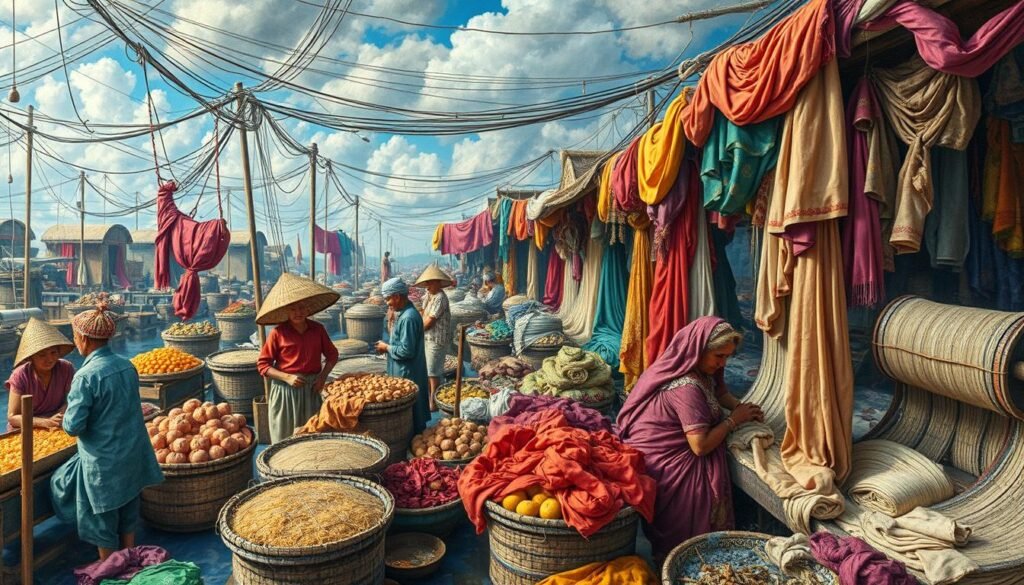“Change is the end result of all true learning.” – Leo Buscaglia. In the silk industry, this quote rings true. The industry is seeing big changes. This is because people want luxury but also care about the planet.
In 2023, the global silk textiles market reached USD 124.2 billion. It is expected to grow at 8.0% each year until 2030. This shows a bounce back from Covid-19 and a move towards new ways of making silk.
Big companies, including Jiangsu Sutong Cocoon and Silk Co. Ltd, are trying new things. They’re making clothes, bedsheets, and more. For a closer look at how Tianruiyi is leading in quality silk, join our talk on the future of this fine material.
Key Takeaways
- The global silk textiles market reached USD 124.2 billion in 2023.
- The industry is set for an 8.0% CAGR from 2024 to 2030.
- Asia-Pacific continues to be the largest market for silk due to its cultural heritage and economic growth.
- Technological advancements are driving demand for sustainable silk products.
- Luxury textiles are reshaping consumer preferences in the fashion industry.
Introduction to the Silk Industry
The silk industry is all about making silk and its long history. It starts with sericulture, which is raising silkworms, mainly the mulberry silkworm Bombyx mori. This is key to getting high-quality silk.
Silk is known for feeling luxurious and its lasting appeal. It’s been used in clothes and home decor across many cultures. The need for fine silk has led to new, sustainable methods in its making.
Lately, new tech has made silk-making better. It now produces more and hurts the environment less. There’s a growing trend for items like custom silk pajamas. This shows how the silk industry is changing to meet what people want and love.
The silk market is getting bigger and may be worth about $34.1 billion by 2031. The silk industry keeps its deep history while meeting today’s needs and being mindful of the planet.
Current Market Size and Projections
The silk market size has grown a lot recently, thanks to more demand in many areas, especially textiles. In 2023, the market’s value was about USD 18.7 billion. This shows how strong the industry is. Looking at market projections helps us see what might happen next.
Silk Market Value in 2022
In 2022, the silk market was worth USD 17.9 billion. This indicates strong demand. Mulberry silk played a big part in this, especially in textiles. It made up about 65% of the market. This shows how important silk is in making clothes and in world trade.
Forecasted Growth by 2030
By 2032, the silk market could hit USD 37.3 billion, with a yearly growth of 7.7% from 2023 to 2032. The Asia Pacific area is expected to grow over 8.5% in this time. This growth is thanks to mulberry silk and strong demand for different uses. These positive trends point to a bright future for the silk industry. They show growing customer interest and many ways to use silk.
Factors Driving Demand for Silk
Several factors increase silk’s demand in different industries. Silk is known for its amazing softness, shine, and strength. These features make silk a top choice for clothes for casual outings, fancy night events, and fancy add-ons. Silk keeps winning hearts in both well-known and new markets.
Popularity in Textile Applications
As people earn more, especially in growing areas, they love high-end and healing textiles more. Silk stands out in the textile market because it is high-quality. It screams luxury and rarity. Also, as more folks prefer green and eco-kind fabrics, they choose natural stuff like silk. This change boosts silk’s use in clothes greatly.

| Driving Factor | Description |
|---|---|
| Luxury Appeal | Silk is synonymous with luxury, attracting consumers looking for premium products. |
| Sustainability | Growing interest in eco-friendly textiles encourages the use of natural silk. |
| Diverse Applications | Silk is used in clothing, home textiles, and medical applications, broadening its market reach. |
| Economic Growth | Rising incomes in emerging markets boost the demand for luxury textiles including silk. |
| Online Sales Growth | Shifts toward digital sales channels make silk products more accessible to consumers. |
Emerging Markets and Consumer Preferences
The silk industry is witnessing big changes, especially in Asia-Pacific’s emerging markets. Countries like China and India, with long traditions in silk making, are at the forefront. As people earn more, their love for luxury textiles grows, boosting the demand for top-grade silk.
Growth in Asia-Pacific Region
The Asia-Pacific region is boosting the global silk market significantly. The market’s value is soaring, with expectations to reach new peaks by 2030. The mix of traditional skills and modern tastes is pulling in buyers, creating a unique blend.
Increasing Affluence in Emerging Economies
Growing wealth is expanding silk’s consumer base in these areas. People now prefer luxury brands that reflect their lifestyle, changing how they spend. This move makes knowing consumer preferences crucial for silk manufacturers. High quality and trust in suppliers like Tianruiyi are key to meeting the silk demand increase.
Technological Innovations in Silk Production
New technology has changed how we make silk. We now use genetically modified silkworms and better breeding ways. These help us make more and better silk. They also make silk in a way that’s good for the planet. This appeals to people who care about the environment.
Silk is being used in many different areas now. It’s in fashion, textiles, and even healthcare. People love silk’s softness, strength, and how it doesn’t trigger allergies. For example, it’s starting to be used in medicine and for delivering drugs.
There’s also a move towards eco-friendly materials. Silk-reinforced materials are now a thing in green construction. Digital tools are making it easier to buy and sell silk around the world. These advances help local economies in silk-making places like China, India, and Brazil.
These new technologies in silk making are doing a lot. They are making the industry more efficient. They help the economy too. The silk market is growing. Experts think it will continue to grow from 2023 to 2030.
| Innovation Type | Description | Industry Application |
|---|---|---|
| Genetically Modified Silkworms | Enhanced silk yield and resistance to diseases | Fashion, textiles |
| Silk-Reinforced Composites | Eco-friendly construction materials | Building materials |
| Biomedical Applications | Silk used in drug delivery and regenerative medicine | Healthcare |
| Digital Platforms for Trade | Facilitates global silk sales | Trade |
Challenges Facing the Silk Industry
The silk industry faces big hurdles in the global market. It relies on much labor for silk farming, making costs high. These high costs are a big problem for producers. They struggle with changing prices of raw silk.
The competition from man-made fabrics also creates challenges. While silk has unique qualities, cheaper options like polyester are hard to compete with. This makes it tough for silk to grow.
High Production Costs
Many factors make silk production costly. Sericulture, or silk farming, needs a lot of work, which adds to expenses. Also, costs go up due to feeding silkworms, fighting pests, and disease control.
Farmers have a hard time making customers pay more to cover these costs. This is especially true in markets that are sensitive to price.
Competition from Synthetic Fabrics
Competition with synthetic materials is tough for the silk industry. These man-made fabrics offer similar benefits but are cheaper. This leads to less demand for silk, mainly in the US and Europe.
To keep its place in the market, silk must highlight what makes it special. Its sustainable and luxurious nature needs to be emphasized. Overcoming these challenges is key for its growth and innovation.

| Aspect | Silk Industry | Synthetic Fabrics |
|---|---|---|
| Production Costs | High labor costs, feed, pest control | Lower production expenses |
| Market Demand | Struggling, especially in the US and Europe | Growing due to affordability |
| Unique Qualities | Luxury, sustainability, natural product | Variety in textures and colors |
Silk Industry Growth Trends
The silk industry is changing a lot these days. This is because people now prefer things that are good for the planet. They’re using new ways to make silk that don’t harm the environment. This change is happening because people care more about eco-friendly fashion. They want to buy from brands that also care about the planet. The need for silk made in a good way is going up. This shows how important sustainability has become.
Shifts Towards Sustainable Fashion
The silk industry is becoming more eco-friendly. People now want things that don’t hurt the earth. This has made more brands offer silk that’s made in a safe way. In the past, making silk sometimes harmed the environment. Now, there’s a big move towards organic farming and safer ways to make silk. Brands leading this change are trying to lessen their harm to nature. Having eco-friendly tags on silk products is now key for brands.
Advanced Silk Blending Techniques
There are new ways to make silk that meet different needs. Mixing silk with other green fibers makes it better and unique. These new fabrics are used in health, fashion, and beauty. This shows how varied silk can be. It also brings together luxury and caring for the planet. This attracts even more people.
Regional Insights on Silk Market Trends
The silk industry is changing in different places. This is because of what people like and economic reasons. Knowing about silk trends in the U.S., Europe, and Asia helps us understand the big picture.
Market Dynamics in the United States
The U.S. silk market is expected to grow quite a bit by 2034. People are liking luxury textiles more. The market could be worth about US$ 20 billion by 2024 thanks to high-quality silk products.
Current Trends in Europe and Asia
In Europe, there’s a big move toward silk that’s made the right way. Brands are focusing on making products that don’t hurt the planet. This is because people want luxury that is also responsible.
In Asia, especially China and India, silk is very special. As people have more money, they are buying more luxury silk. China’s silk market and India’s market are both expected to grow. They are making new silk products that people around the world like.
| Region | Forecasted CAGR (2024-2034) | Projected Market Value (2024) |
|---|---|---|
| United States | 8.5% | US$ 20 billion |
| United Kingdom | 9.2% | US$ 6 billion |
| China | 9.0% | US$ 15 billion |
| India | 8.8% | US$ 7 billion |
It’s important to know about these silk market studies. They show us where there are chances to grow in the silk business. The way luxury, caring for the planet, and traditions mix shapes the silk markets in these places.
Conclusion
The silk industry is about to grow a lot. Experts think it will go from USD 3742.8 million in 2023 to USD 4309.4 million by 2030. That’s a growth rate of 2.0% every year, showing its strong future.
There are big challenges and chances for growth. One major issue is the cost of making silk and competition from fake fabrics. But more people now want clothes that don’t harm the earth. This is making companies think of new ways to make silk. They are using new machines and ways to color silk that keep its rich feel but make more.
The future of silk depends on mixing old ways with new demands. By using new ideas and keeping up with changes, silk can stay important in clothing all over the world. It will face both good times and tough ones as it moves forward.
FAQ
What is the primary material used in the production of silk?
Silk is made from the cocoon of the silkworm. This process is called sericulture.
How has consumer demand for silk changed recently?
Recently, more people want silk because it’s a luxury, eco-friendly, and high-quality material. It is soft and strong.
What are the forecasted growth rates for the silk market?
The silk market is expected to grow by 8.30% yearly. By 2030, it could reach USD 771.62 million. By 2034, it might hit USD 44.6 billion, growing at 8.4% each year.
Which regions are seeing the most significant growth in silk production and consumption?
The Asia-Pacific region is growing fast in silk. Countries like China and India are leading due to more money and fashion interest.
What are some technological innovations impacting silk production?
New methods in silk production include better silkworm breeding, efficient processing, and advances in tech and medical textiles.
What challenges does the silk industry currently face?
Silk production is costly because of labor and food for silkworms. It also competes with cheaper materials like polyester.
How is the silk industry adapting to sustainable practices?
The silk industry is using organic farming and eco-friendly methods. They want to make silk in a responsible way.
What trends are influencing the luxury silk market?
The luxury silk market is being shaped by eco-fashion, natural material interest, and new silk blending ways. These create varied products.
What is the outlook for the silk market in the United States?
The U.S. silk market is likely to grow by 8.5% annually until 2034. This growth is supported by the strong fashion scene.
How do European countries contribute to the silk market growth?
European countries are leaning towards sustainable and ethically produced silk. This supports the luxury silk market’s growth.




